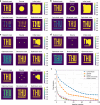Advancements and challenges in inverse lithography technology: a review of artificial intelligence-based approaches
- PMID: 40701983
- PMCID: PMC12287475
- DOI: 10.1038/s41377-025-01923-w
Advancements and challenges in inverse lithography technology: a review of artificial intelligence-based approaches
Abstract
Inverse lithography technology (ILT) is a promising approach in computational lithography to address the challenges posed by shrinking semiconductor device dimensions. The ILT leverages optimization algorithms to generate mask patterns, outperforming traditional optical proximity correction methods. This review provides an overview of ILT's principles, evolution, and applications, with an emphasis on integration with artificial intelligence (AI) techniques. The review tracks recent advancements of ILT in model improvement and algorithmic efficiency. Challenges such as extended computational runtimes and mask-writing complexities are summarized, with potential solutions discussed. Despite these challenges, AI-driven methods, such as convolutional neural networks, deep neural networks, generative adversarial networks, and model-driven deep learning methods, are transforming ILT. AI-based approaches offer promising pathways to overcome existing limitations and support the adoption in high-volume manufacturing. Future research directions are explored to exploit ILT's potential and drive progress in the semiconductor industry.
© 2025. The Author(s).
Conflict of interest statement
Conflict of interest: The authors declare no competing interests.
Figures











Similar articles
-
Enhancing ultrasonographic detection of hepatocellular carcinoma with artificial intelligence: current applications, challenges and future directions.BMJ Open Gastroenterol. 2025 Jul 1;12(1):e001832. doi: 10.1136/bmjgast-2025-001832. BMJ Open Gastroenterol. 2025. PMID: 40592728 Free PMC article. Review.
-
GAN-enhanced deep learning for improved Alzheimer's disease classification and longitudinal brain change analysis.Front Med (Lausanne). 2025 Jun 17;12:1587026. doi: 10.3389/fmed.2025.1587026. eCollection 2025. Front Med (Lausanne). 2025. PMID: 40600033 Free PMC article.
-
Advancements in Herpes Zoster Diagnosis, Treatment, and Management: Systematic Review of Artificial Intelligence Applications.J Med Internet Res. 2025 Jun 30;27:e71970. doi: 10.2196/71970. J Med Internet Res. 2025. PMID: 40587773 Free PMC article. Review.
-
Research status, hotspots and perspectives of artificial intelligence applied to pain management: a bibliometric and visual analysis.Updates Surg. 2025 Jun 28. doi: 10.1007/s13304-025-02296-w. Online ahead of print. Updates Surg. 2025. PMID: 40580377
-
The Use of AI for Phenotype-Genotype Mapping.Methods Mol Biol. 2025;2952:369-410. doi: 10.1007/978-1-0716-4690-8_21. Methods Mol Biol. 2025. PMID: 40553344
References
-
- Wang, Y. B. et al. Photonic-circuit-integrated titanium: sapphire laser. Nat. Photonics17, 338–345 (2023).
-
- El Helou, C. et al. Mechanical integrated circuit materials. Nature608, 699–703 (2022). - PubMed
Publication types
Grants and funding
- 62235009/National Science Foundation of China | National Natural Science Foundation of China-Yunnan Joint Fund (NSFC-Yunnan Joint Fund)
- 62235009/National Science Foundation of China | National Natural Science Foundation of China-Yunnan Joint Fund (NSFC-Yunnan Joint Fund)
- 62235009/National Science Foundation of China | National Natural Science Foundation of China-Yunnan Joint Fund (NSFC-Yunnan Joint Fund)
- 62235009/National Science Foundation of China | National Natural Science Foundation of China-Yunnan Joint Fund (NSFC-Yunnan Joint Fund)
- 62235009/National Science Foundation of China | National Natural Science Foundation of China-Yunnan Joint Fund (NSFC-Yunnan Joint Fund)
LinkOut - more resources
Full Text Sources

